 Advances in Pure Mathematics, 2012, 2, 220-225 http://dx.doi.org/10.4236/apm.2012.24032 Published Online July 2012 (http://www.SciRP.org/journal/apm) Minimal Surfaces and Gauss Curvature of Conoid in Finsler Spaces with (α, β)-Metrics* Dinghe Xie, Qun He Department of Mathematics, Tongji University, Shanghai, China Email: x_dinghe8707@126.com Received December 26, 2011; received March 18, 2012; accepted March 26, 2012 ABSTRACT In this paper, minimal submanifolds in Finsler spaces with (α, β)-metrics are studied. Especially, helicoids are also minimal in (α, β)-Minkowski spaces. Then the minimal surfaces of conoid in Finsler spaces with (α, β)-metrics are given. Last, the Gauss curvature of the conoid in the 3-dimension Randers-Minkowski space is studied. Keywords: Isometrical Immersion; Minimal Submanifold; (α, β)-Metric; Conoid Surface; Gauss Curvature 1. Introduction In recent decades, geometry of submanifolds in Finsler geometry has been rapidly developed. By using the Busemann-Hausdorff volume form, Z. Shen [1] intro- duced the notions of mean curvature and normal curva- ture for Finsler submanifolds. Being based on it, Bern- stein type theorem of minimal rotated surfaces in Rand- ers-Minkowski space was considered in [2]. Later, Q. He and Y. B. Shen used another important volume form, i.e., Holmes-Thompson volume form, to introduce notions of another mean curvature and the second fundamental form [3]. Thus, Q. He and Y. B. Shen constructed the corre- sponding Bernstein type theorem in a general Minkowski space [4]. The theory of minimal surfaces in Euclidean space has developed into a rich branch of differential geometry. A lot of minimal surfaces have been found in Euclidean space. Minkowski space is an analogue of Euclidean space in Finsler geometry. A natural problem is to study minimal surfaces with Busemann-Hausdorff or Holmes- Thompson volume forms. M. Souza and K. Tenenblat first studied the minimal surfaces of rotation in Randers- Minkowski spaces, and used an ODE to characterize the BH-minimal rotated surfaces in [5]. Later, the nontrivial HT-minimal rotated hypersurfaces in quadratic (α, β)- Minkowski space are studied [6]. N. Cui and Y. B. Shen used another method to give minimal rotational hyper- surface in quadratic Minkowski (α, β)-space [7]. How- ever, these examples only consider the special (α, β)- metrics either Randers or quadratic. Therefore, what is the case with the general (α, β)-metric? The main purpose of this paper is to study the conoid in (α, β)-space. It includes minimal submanifolds in Finsler spaces with general (α, β)-metric (F ) and the Causs curvature in Randers-Minkowski 3-space. We present the equations that characterize the minimal hypersurfaces in general (α, β)-Minkowski space. We prove that the conoid in Minkowski 3-space with metric F :0,FTM is minimal if and only if it is a helicoid or a plane under some conditions. Finally, similar to [7], we give the Gauss curvature of conoid in Randers-Min- kowski 3-space and point out that the Gauss curvature is not always nonpositive on minimal surfaces. 2. Preliminaries Let M be an n-dimensional smooth manifold. A Finsler metric on M is a function satisfying the following properties: 1) F is smooth on \0TM ; 2) ,, xy Fxy 0 for all ; 3) The induced quadratic form g is positively definite, where 2 :,dd, 1 :. 2ij ij ij ij yy gxyx x gF (1) Here and from now on, i , ij y F mean , i y 2 ij yy 1,,;1 ,,.ijnm n , and we shall use the following convention of index ranges unless otherwise stated: *Project supported by NNSFC (no. 10971239, no. 10771160) and the atural Science Foundation of Shanghai (no. 09ZR1433000). C opyright © 2012 SciRes. APM 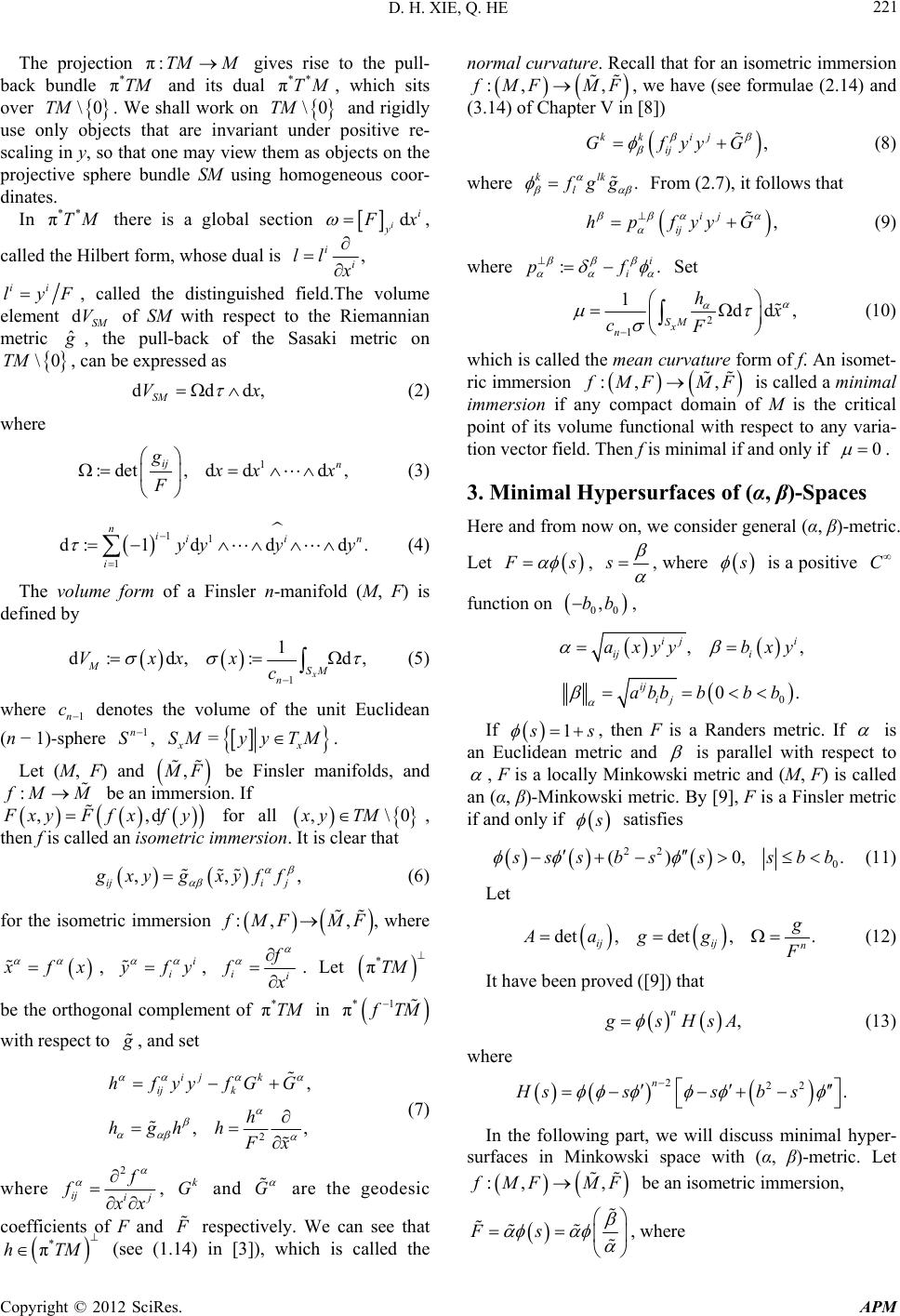 D. H. XIE, Q. HE 221 The projection gives rise to the pull- back bundle and its dual , which sits over . We shall work on and rigidly use only objects that are invariant under positive re- scaling in y, so that one may view them as objects on the projective sphere bundle SM using homogeneous coor- dinates. π:TM M ** πTM \0TM ** πTM * πTM \0TM In there is a global section d i i y x , called the Hilbert form, whose dual is , i i ll ii lyF dV ˆ , called the distinguished field.The volume element SM of SM with respect to the Riemannian metric , the pull-back of the Sasaki metric on , can be expressed as \0TM ddd,Vx SM (2) where 1 dd, n :det, d ij g xx d d i n y y F (3) 11 1 d:1 d nii i yy . (4) The volume form of a Finsler n-manifold (M, F) is defined by 1 1d, x SM n c d: d,: M Vxxx 1n c (5) where denotes the volume of the unit Euclidean (n − 1)-sphere , 1n S xx y yTM=SM , . Let (M, F) and F be Finsler manifolds, and : MM , be an immersion. If ,d xyF fxf y for all ,\0TM ,, i j xy , then f is called an isometric immersion. It is clear that , ij xygxy ff , (6) for the isometric immersion :, MF MF , where fx , i i fy , ii f . Let * πTM be the orthogonal complement of in * πTM *1 π TM with respect to , and set 2 , ,, k k fGG h h ij ij hfyy hgh x (7) where 2 ij ij f x k G G, and are the geodesic coefficients of F and * πhT respectively. We can see that (see (1.14) in [3]), which is called the normal curvature. Recall that for an isometric immersion M :, , MF MF , we have (see formulae (2.14) and (3.14) of Chapter V in [8]) , kk ij ij GfyyG . klk l (8) gg where From (2.7), it follows that , ij ij hpfyyG :. i i pf (9) where Set 2 1 1dd, SM x n h cF (10) which is called the mean curvature form of f. An isomet- ric immersion :, , MF MF 0 is called a minimal immersion if any compact domain of M is the critical point of its volume functional with respect to any varia- tion vector field. Then f is minimal if and only if . 3. Minimal Hypersurfaces of (α, β)-Spaces Here and from now on, we consider general (α, β)-metric. Let s C is a positive s , , where function on 00 ,bb , ,, ij i ij i axyy bxy 0 0. ij ij abbbb b 1 If s , then F is a Randers metric. If is an Euclidean metric and is parallel with respect to , F is a locally Minkowski metric and (M, F) is called an (α, β)-Minkowski metric. By [9], F is a Finsler metric if and only if satisfies 22 0 () 0, .ss bsssbb (11) Let det ,det,. ijij n Aag g , n (12) It have been proved ([9]) that sHsA 222 . n Hsssb s (13) where In the following part, we will discuss minimal hyper- surfaces in Minkowski space with (α, β)-metric. Let :, ,MFMF be an isometric immersion, Fs , where Copyright © 2012 SciRes. APM 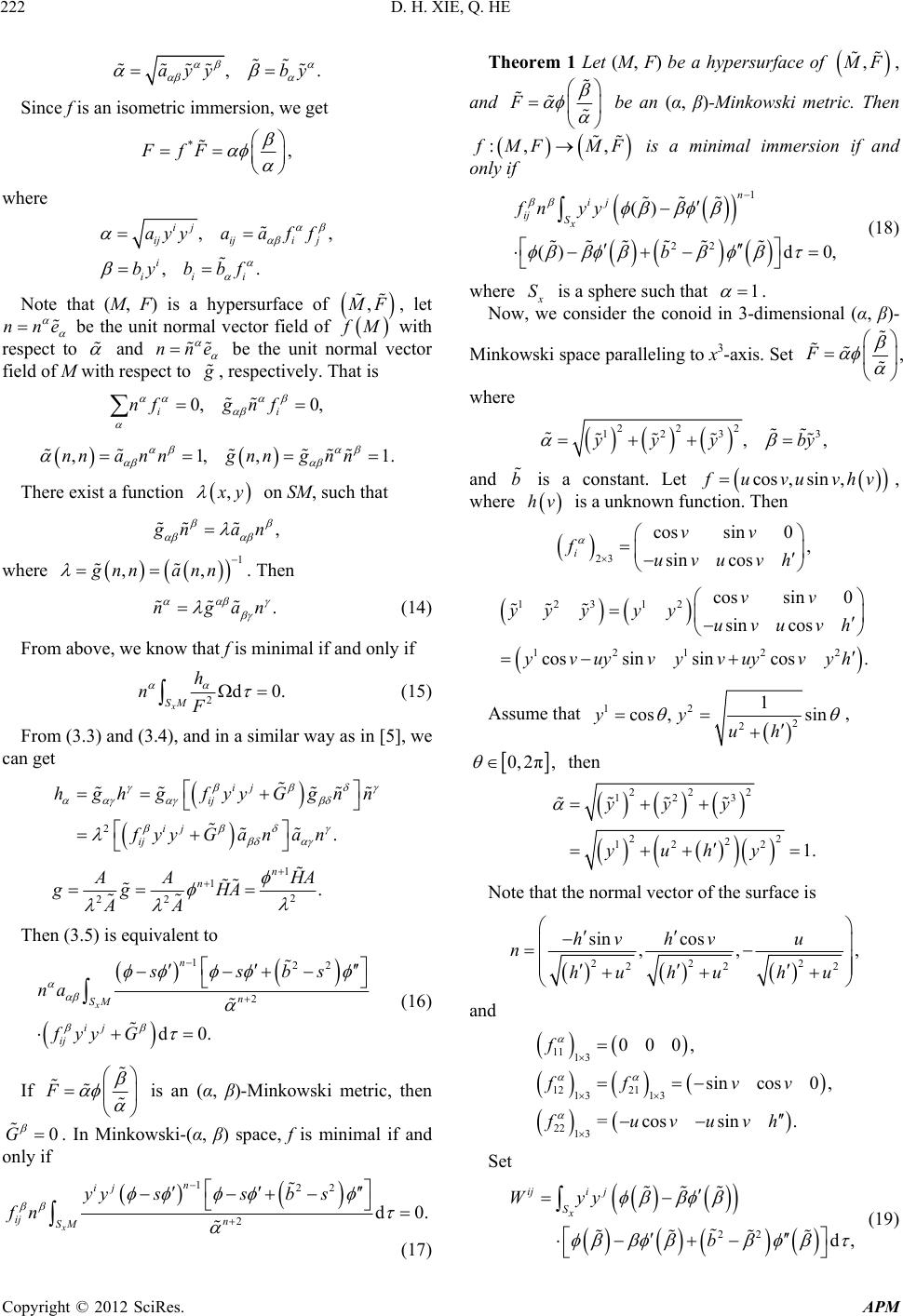 D. H. XIE, Q. HE 222 , ,.yy bya tric immer Since f is an isomesion, we get * Ff ,F where ,, ,. j i iii ayyaa f f bybbf ij ijij i hat (M, F) is a hype of , Note trsurface F , let nne be the unit normeld of al vector fi M with respect to and nne it nmal vector fiel ect to be the unor d of M with resp ely. That is , respectiv 0, 0, ii nfg nf ,1,1.nnangnngn n ,n There exist a function , y on SM , sch that , u nan 1 ,,ann where gnn . Then ga.n n 14) From above, we know that f is minial if and only if ( m 2d0. h F (15) ca G x SM n From (3.3) and (3.4), a nd in a similar way as in [5], we n get ij ij ij hghg fyy gnn 2. ij fy yG an an 1 2. n1 22 n AHA gg HA AA Then (3.5) is equivalent to d0. ij ij fy y G 122 2 x n n SM ssbs na (16) If F is an (α, β)-Minkowski metric, 0. In Minkowski-(α, β) space, f is minimal if and only if then G 122 n ssbs 2 xn d0. ij ij SM yy fn em 1 Let (M, F) be a hypersurface of (17) Theor F , and F be an (α, β)-Minkowski metric. Then :, , MF MF is a minimal immersion if and only if 22 () ij ij Sx fn yy b 1n () d 0, (18) S is a sphere such that 1 where . Now, we consider the conoid in 3-dimensional (α, β)- Minkowski space paralleling to x3-axis. Set , F where 222 123 3 ,, yy by and b is a constant. Let sin , cos , uvu, vhv where hv is a unknown function. Then 23 cossin0 , sin cos i vv fuvu vh 1 12122 cossin 0 s cossin sincos. vv vh yvuyvyvuy vyh 23 12 sin co yy yyyuvu Assume that 12 2 2 1 cos ,sinyy uh , 0, 2π, then 222 123 22 2 12 2 1. yy y yuhy Note thatal vector of the surface is the norm 22 2 22 2 sin cos ,, , hvh vu n hu huhu and 11 13 12 21 13 13 22 13 000, sincos0 , =cos sin. f ff vv fuvuvh Set 22 d, ijij Sx Wyy b (19) Copyright © 2012 SciRes. APM 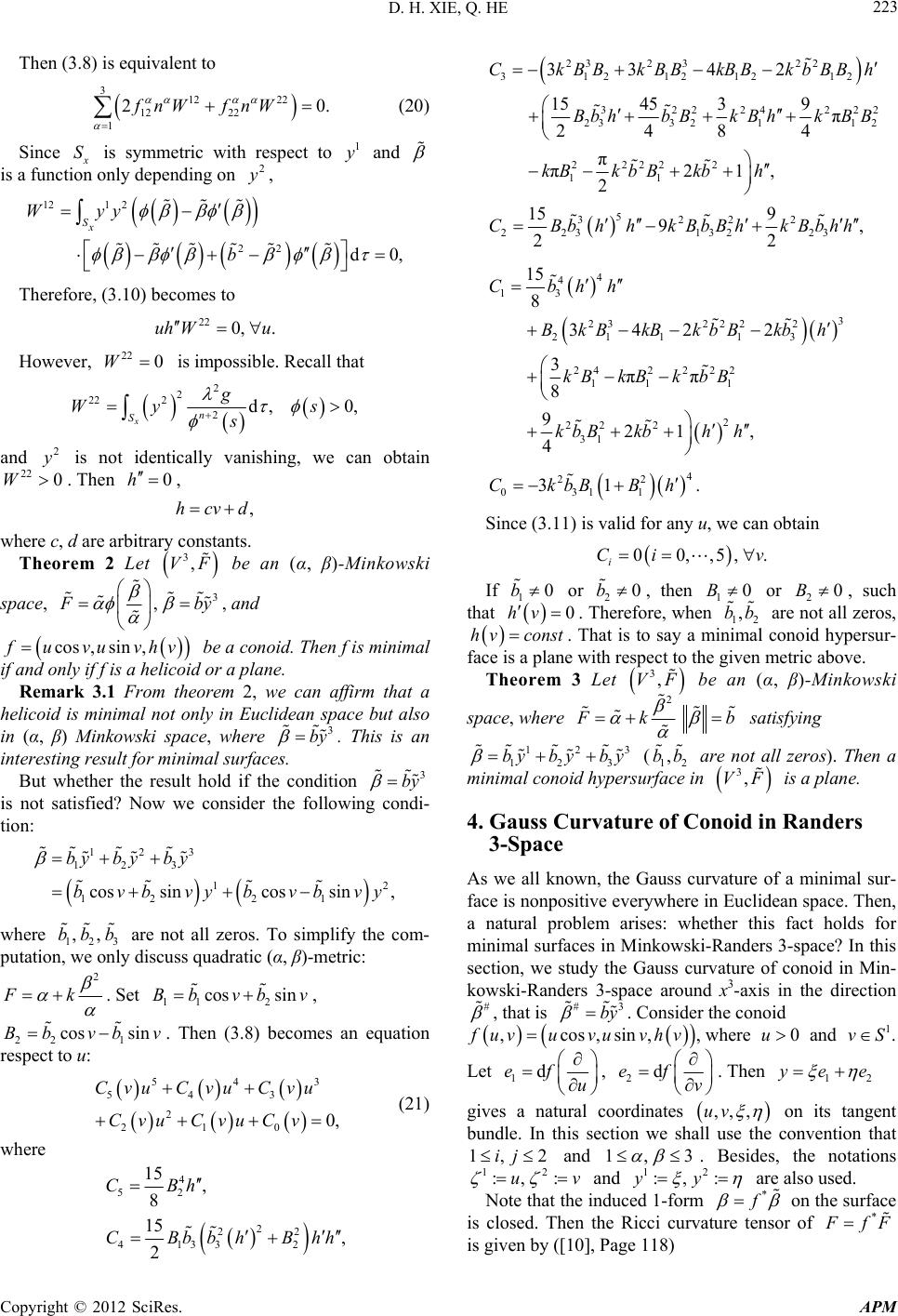 D. H. XIE, Q. HE 223 Then (3.8) is equivalent to 22 22 20.nW (20) Since 312 12 1 fnW f S is symmetric with resp 1 ect to and ision onlyding on a funct depen 2 , 121 2 22 Sx Wyy b d 22 0, .W u ver, 22 0W is impossible. Recall th 0, Therefore, (3.10) becomes to uh Howe at 2 2 22 2 2d, 0 xn S g Wys s , and 2 is not identically vanishing, we can obtain W. Then 0h , ,hcvd wThe Let 3,VF be an (α, β)-Minkowski 22 0 here c, d are arbitrary constants. orem 2 space, 3 , by , and sin,cos , uv if and only if f i uvhv be a conoid. Then f imal s a helicoid or a plane. ma helicoid al nt in (α, β)ski swhere 3 by . This is an interesting result for minisurf ition 3 by is we co tion: s mini Rerk 3.1 From theorem 2, we can affirm that a is minim o only in Euclidean space but also Minkowpace, mal aces. But whether the result hold if the cond not satisfied? Nownsider the following condi- 123 12 3 cossin byb yby bvbv 12 12 21 cossin ,ybvbvy where 123 ,,bbb are not all zeros. To simplify the com- putation, we only discuss quadratic (α, β)-metric: 2 Fk . Set 112 cos sinBb vbv , 3 3 0 0, Cvu uCv (21) where 22 1 cos sinBbvb v . Then (3.8) becomes an equation respect to u: 54 54 2 21 Cv u Cvu Cvu Cv 4 52 15 , 8 CBh 2 22 133 2 , 2B bbhB 4 15 C hh 23 12 32224222 23321 2222 2 11 15 4539 π 2484 π π21, 2 B Bb hbBkB hkB B kBkbB kbh 2 322 3 121212 3342CkBkBBkBBkbBBh 1 2 5 3222 22313223 15 9 9, 22 CBbhhkBbBhkBbhh 4 4 13 3 23222 2 211 13 242222 111 2 22 2 31 15 8 342 2 3ππ 8 921 , 4 Cbhh BkBkBkbBkbh kBkBk bB kbBkbh h 4 22 0311 31 .CkbBBh Since (3.11) is valid for any u, we can obtain 00,,5,. i Ci v If 10b or 20b , then 10B or 20B , such that . Therefore, when 12 ,bb are not all zeros, 0hv hv const. That is to say a minimal conoid hypersur- face is a plane with respect to the given metric above. Theorem 3 Let 3,VF be an (α, β)-Minkowski space, where 2 Fk b satisfying 123 byb yby (,bb are not all zeros). Then a mne. 4. Gauss Curvature of Conoid in Randers all kn m dy the Gauss curvatun Min- kowski-Randers 3-space around x 3-axis in the direction # 12 312 inimal conoid hypersurface in 3,VF is a pla 3-Space As we own, the Gauss curvature of a minimal sur- face is nonpositive everywhere in Euclidean space. Then, a fact honatural problem arises: whether this lds for inimal surfaces in Minkowski-Randers 3-space? In this section, we sture of conoid i , that is #3 by . Consider the conoid ,cos,sin, uvuvuvh v, w0 and vShere u1 . Let 1def u , 2def v . Then 12 ye e es a natur gival coordinates ,,,uv on its tangent bundle. In this section we shall use the convention that 1, 2ij and 1, 3 . Besides, the notations 12 :, :uv and 12 :, :yy are also used. Note that the induced 1-form * on the surface is closed. Then the Ricci curvature tensor of * fF is given by ([10], Page 118) Copyright © 2012 SciRes. APM 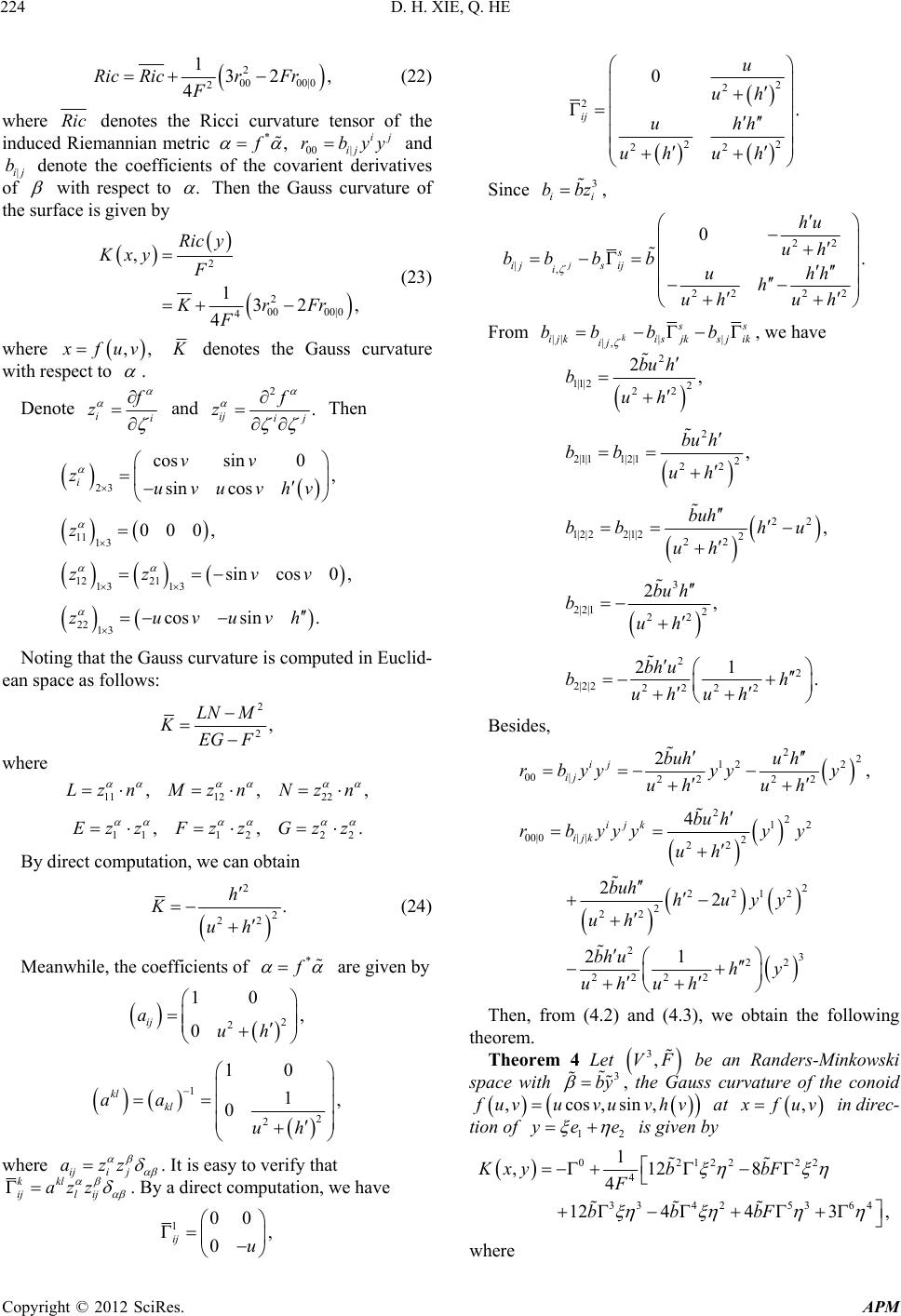 D. H. XIE, Q. HE 224 23 4 Ric Ricr F where 2 00 00|0 12 ,Fr (22) Ric denotes the Ricci curvature tensor of the ced Riemindu* annian metric , 00 r efficients of the covarie | ij ij byy and b denote the cnt derivatives |ij of o with respect to . Thuss curvature of the surface is given by en the Ga 2 2 132, 4 F KrFr 00 00|0 4 Ricy K,xy (23) where ,, fuv denotes the Gau to ss curvature with respect . te Denoii z and 2 . ij ij f z Then 23 cossin0 , sin cos i vv zu vhv 000, cos0 ,vv ature is computed in Euclid- ean space as follows: v u 11 13 z 12 21 1313 sinzz cos sizuv 22 13 e Gauss curv n .uvh Noting that th 2 2, LN M EG F wher 22 ,,,LznMznNz n K e 11 12 22 .Gzz 11 12 ,,Ezz Fzz n obtain By direct computation, we ca 2 2 22 . h (24) cients of * K i uh Meanwhile, the coeff are given by 2 10 , uh ij 2 0 a 1 0 kl kl aa where iji j azz 2 2 10 1, uh . It is easy to verify that kkl ijl ij azz . By a direct computation, we have 100 , 0 ij u 2 2 2 22 22 0 . ij u uh uhh uh uh Since 3 ii bbz, 22 0 . s s ij hu uh b b |, 22 22 j ij i bb uh h uh uh h From ||| | |, k s ijkisjksj ik ij bb bb , we have 2 1|1| 22 22 2, bu h b uh 2 2|1|12|12 22 , buh bb uh 1| 22 1| 2| 22|1| 22 22 , buh bb hu uh 3 2|2|1 2 22 2, buh b uh 2 2 2|2|2 2222 21 . bh u bh uhuh Besides, 22 12 2 00 |22 22 2, ij ij buhu h rbyyyyy uh uh 22 12 00|0| |2 22 2 2212 2 22 23 22 2222 4 22 21 ijk ijk bu h rbyyyyy uh buh huyy uh bh uhy uh uh (4.2) and (4.3), we obtain the following theorem. Theorem 4 Let Then, from 3,VF be an Randers-Minkow space with 3 by , the Gauss curvature of the conoid ski ,cos,sin,uvuvuvhv at , fuv in direc- tion of 12 yee is given by 0212222 4 334253 64 1 ,128 4 12443, Kxyb bF F bbbF where Copyright © 2012 SciRes. APM 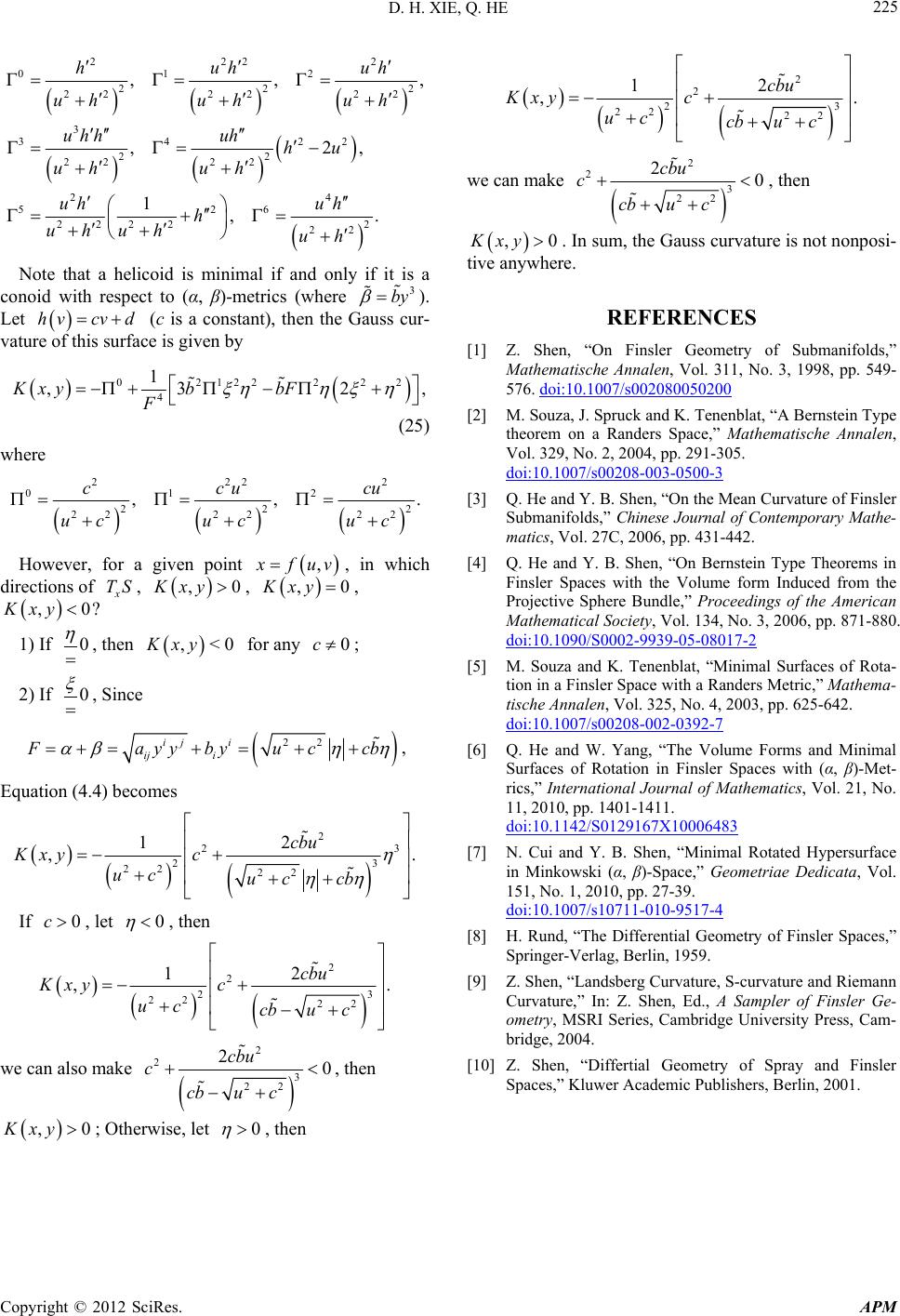 D. H. XIE, Q. HE APM 225 Copyright © 2012 SciRes. 222 01 22 22 22 3 34 2 2 2 22 2 22 22 22 24 526 2222 2 22 ,,, ,2, 1,. huhuh uh uhuh uhhuh hu uh uh uh uh h uhuh uh to (α, 3 2 Note that a helicoid is minimal if and only if it is a conoid with respectβ)-metrics (where by ). Let hvcv d (c is a constant), then the Gauss cur- vate y ur of this surface is given b 222 4 12,y bF F (25 where 02122 ,3Kx b ) 222 2 12 22 2 22 2222 ,, . ccucu uc ucuc However, for , 0 a given point fuv, in which directions of TS, ,0?y ,0Kxy, ,0Kxy, 1) Kx If 0 , then ,<0Kxy for any 0c; 2) If 0 , Since 22ij i ij i ayy byu ccb , Equation (4.4) becomes 2 3 3 cbu Kxy c uc uc cb 0, let 0 2 2 22 22 12 ,. If c , then 2 3 22 . cbu u c we ca 2 2 22 12 ,Kxy c uc cb an also mke 2 u 2 3 22 20 cb c cbu c , then ,0Kxyrwise, let 0; Othe , then 2 2 23 22 22 12 ,. cbu Kxy c uc cbuc we can make 2 2 3 2 20 cbu cb c 2 c u , then ,0Kxy. In sum, the Gauss curvature is not nonposi- tive anywhere. REFERENCES Finsler Geometry of Submanifolds,” Mathematische Annalen, Vol. 311, No. 3, 1998, pp. 549- 576. do 50200 [1] Z. Shen, “On i:10.1007/s0020800 a, J. Spruck and K[2] M. Souz. Tenenblat, “A Bernstein Type theorem on a Randers Space,” Mathematische Annalen, Vol. 329, No. 2, 2004, pp. 291-305. doi:10.1007/s00208-003-0500-3 [3] Q. He and Y. B. Shen, “On the Mean Curvature of Finsler Submanifolds,” Chinese Journal of Contemporary Mathe- l. 27C, 2006, pp. 431-442. [4] Q. He and Y. B. Shen, “On Bernstein Type Theorems in Finsler Spaces with the Volume form Induced from the Projecti /S0002-9939-05-08017-2 matics, Vo ve Sphere Bundle,” Proceedings of the American Mathematical Society, Vol. 134, No. 3, 2006, pp. 871-880. doi:10.1090 [5] M. Souza and Kl Surfaces of Rota- tion in a FinslMetric,” Mathema- . Tenenblat, “Minima er Space with a Randers tische Annalen, Vol. 325, No. 4, 2003, pp. 625-642. doi:10.1007/s00208-002-0392-7 [6] Q. He and W. Yang, “The Volume Forms and Minimal Surfaces of Rotation in Finsler Spaces with (α, β)-Met- rics,” International Journal of Mathematics, Vol. 21, No. 11, 2010, pp. 1401-1411. doi:10.1142/S0129167X10006483 [7] N. Cui and Y. B. Shen, “Minimal Rotated Hypersurface in Minkowski (α, β)-Space,” Geometriae Dedicata, Vol. 151, No. 1, 2010, pp. 27-39. doi:10.1007/s10711-010-9517-4 [8] H. Rund, “The Differential Geometry of Finsler Spaces,” Springer-Verlag, Berlin, 1959. [9] Z. Shen, “Landsberg Curvature, S-curvature and Riemann Curvature,” In: Z. Shen, Ed., A Sampler of Finsler Ge- ometry, MSRI Series, Cambridge University Press, Cam- bridge, 2004. [10] Z. Shen, “Differtial Geometry of Spray and Finsler Spaces,” Kluwer Academic Publishers, Berlin, 2001.
|